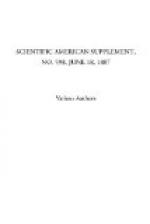During the discussion which followed, Mr. John said that, both as regarded the mercantile marine and the Royal Navy, there were few data to work upon, but few ships having been built with twin screws. Mr. Linnington’s proportions of pitch to diameter of 1.2 to 1.34 was not invariably adhered to. He mentioned a couple of small twin screw vessels where the proportion of pitch to diameter came nearly to 1.5, and he remembered a few years ago the propellers in one of these vessels being changed and the pitch increased, the result being a very considerable improvement. He believed they might go with quick running twin screw engines to a larger proportion of pitch to diameter than they could with a single screw. He might instance the change in the Iris. She was first engined with the pitch equal to the diameter, and she gained two knots or thereabout when the diameter was reduced 2 ft. and the pitch increased 2 ft.
Admiral De Horsey said that he tried experiments with the single screw in the Aurora. She had a feathering serew, and when the sails were used to assist, they commonly altered the pitch of the screw according to the strength of the wind. The screw could be altered while it was revolving, and as the wind freshened they coarsened the pitch, and when they wanted to stop the engines they coarsened the pitch so as to bring the screw right fore and aft, so that they never altered the way of the ship in changing from steam to sail alone. The reason why twin screws had been adopted in the navy was that if one was damaged there was the other still available. But it gave them a still further advantage, as it enabled them to have a fore and aft bulkhead, which with a single screw was difficult. The mercantile marine had not as yet looked favorably on twin screws. Their finest and fastest ships were single screws, probably because, in very bad weather, the single screw was better.
Mr. Spyer said that in designing propellers for ships of war, they were obliged to attempt to obtain the highest possible speed, and that was not necessarily coincident with a propeller of maximum efficiency. On the other hand, for mercantile purposes, coal consumption was obviously of paramount importance, and the speed of any particular vessel must be obtained with the smallest possible amount of indicated horse power, and a propeller of maximum efficiency. Regarding the position of the propellers in a small pinnace, the propellers were shifted six or seven inches further out, and with about ten per cent. less indicated horse power she obtained three tenths of a knot more speed.




